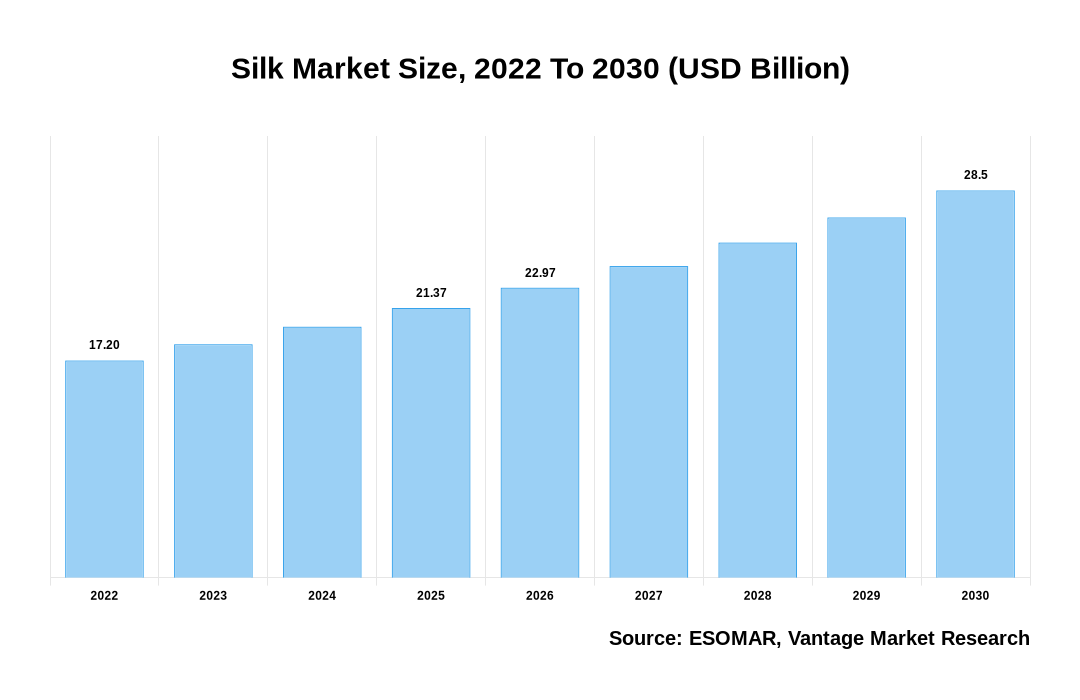Global Silk Market
As stated in our extensive report; the Global Silk Market accounted for USD 17.2 Billion in 2022.
The demand for textiles and apparel is continually rising and changing, and Silk is one of the essential global contributors to this industry. Silk fiber has several desirable characteristics, including an opulent feel, a shiny appearance, tenacity, strength, and lightweight. Many domestic products, such as wall hangings, cushions, upholstery, draperies, and numerous clothes, including scarves, neckties, and bridal gowns, also frequently employ Silk. Moreover, Silk conducts electricity less than other materials, encouraging its usage in ties, shirts, haute couture clothing, formal dress suits, robes, kimonos, and sundresses. The aforementioned significant elements are anticipated to enhance the demand for Silk, which might ultimately result in a flourishing worldwide Silk market expansion.

Click To Get a Free Sample On the Research Study
Key factors influencing Silk Market Growth
The growth of the global Silk market can be attributable to the following:-
- Sericulture’s technological advancements significantly impact the Silk market’s growth, and the sector’s low capital intensity will support market expansion.
- The demand for Silk has increased during the predicted period due to the textile industry’s phenomenal recent growth.
- Less capital is needed due to the lack of complicated machinery and equipment for Silk production. Globally, businesses that require more investment are more labor-intensive than the Silk industry. The market expansion is anticipated to be influenced by these factors.
- For the Silk protein market to expand in the coming years, more research and education regarding seri-byproducts and seri-waste products will be necessary. The fact that Silk proteins contain dipeptides and tripeptides, which may easily cross the dermis skin layer and enter the bloodstream, is one of the key factors contributing to the increased use of Silk proteins in various industries.
- Silk protein is also advantageous for many production applications in the cosmetics and supplement industries due to the presence of ingredients such as natural amino acids.
- A greater understanding of the benefits of employing lubricant-based goods due to their corrosion resistance, inflammability, and lack of harmful ingredients will further accelerate the growth rate of the Silk market.
On the other hand, the fluctuation of Silk material prices is one of the elements limiting the expansion of the Silk market. Furthermore, inadequate market and storage facilities, limited transportation alternatives, and insufficient knowledge of market trends, particularly in some nations, are further problems impeding the worldwide market.
Asia Pacific Region to Capture the Market
The Asia Pacific region is predicted to dominate the global Silk market due to multiple dominating players and the rising popularity of aggressive marketing tactics. Also, a developing Silk market in Asia Pacific will expand due to the increasing demand for Silk from developing nations like India, Thailand, and Uzbekistan. According to data from several government organizations, India produced nearly 26,500 metric tonnes of Silk in 2021, mainly in the significant Silk-producing states of Andhra Pradesh, Gujarat, Karnataka, Assam, and Bihar, among others. In addition, the growing population boom and the increasing number of start-ups joining the market are also anticipated to assist the expanding demand for Silk from Asia Pacific.
Conclusion
Sericulture’s technological development and the industry’s low capital intensity have positively impacted the overall sales of Silk products.
Some of the key players in the Global Silk Market include- Anhui Silk Co. Ltd. (China), AmSilk GmbH (Germany), Wujiang First Textile Co. Ltd. (China), Zhejiang Jiaxin Silk Co. Ltd. (China), Sichuan Nanchong Liuhe (Group) Corp. (China), ShengKun Silk Manufacturing Co. Ltd. (China) and others.
![[Market Research Reports] – Research Google News Blog | VMR.Biz](https://www.vmr.biz/wp-content/uploads/2022/12/logo-removebg-preview.png)











